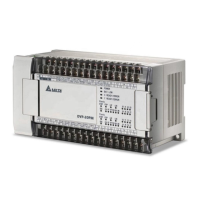11 CANopen Communication Card
Setting communication in an A2 mode:
Setting the ASDA-A2 series servo drives
Before creating a CANopen connection, the users have to set the servo drives to CANopen
mode.
1. Set P1-01 to H’0B. (The servo drive is set to CANopen mode.)
2. Set P3-00. The value of P3-00 indicates a node number. It is in the range of H’01 to H’04.
3. Set P3-01 to H’0403. The value of P3-01 indicates a baud rate. (If the high byte of the value
of P3-01 is 2, the baud rate used is 500 kbps. If the high byte of the value of P3-01 is 4, the
baud rate used is 1 Mbps.) The baud rates which are supported by DVP-FPMC now are 1
Mbps and 500 kbps. (Default: 1 Mbps)
Setting DVP-FPMC
After the setting of the CNopen parameters in the servo drives connected is completed, the
users can create a CANopen network by means of DVP-FPMC.
1. Write 1 into CR#500. DVP-FPMC is set to A2 mode.
2. Write a node ID into CR#053. The default node ID of DVP-FPMC is 127.
3. Write H’FFFF into CR#010. All servo drives which are connected are scanned.
4. Read the value in CR#010 by means of the instruction FROM, and check whether the value
in CR#010 is cleared to 0.
5. Write 1 into CR#050. All servo drives which has been connected are set to ON.
Normal mode
In a normal mode, users have to set the PDO parameters in DVP-FPMC and the slaves which are
connected. They have to use FROM/TO to set control registers in DVP-FPMC, and use an SDO
protocol to set the PDO parameters in the servo drives connected. The steps of setting the PDO
parameters in DVP-FPMC are as follows.
1. Setting PDO transmission parameters
The setting of PDO parameters includes the setting of a frame ID and the setting of a
synchronization cycle. A frame ID is in the range of H’181 to H’578. Please note that the frame
ID and the synchronization cycle in the PDO for a master must be the same as the frame ID and
the synchronization cycle in the PDO for the slave connected. There are two kinds of PDOs:
transmit and receive PDOs (TPDO and RPDO).
Setting a TPDO
CR#H’1800~CR#H’183F in DVP-DPMC function as TPDOs. They communicate with a
slave’s RPDOs. For example, the OD index H’1800 (TPDO) in a master communicates with
the OD index H’143F (RPDO) in a slave. The synchronization cycle set is 240, and the
frame ID set is H’181.
Transmit PDO
DVP-FPMC
Receive PDO
CR#
OD
index
Slave
H'1800
Synchronization
cycle=240
Frame ID=H'181
H'143F
Synchronization
cycle=240
Frame ID=H'181
Setting a RPDO
CR#H’1400~CR#H’143F in DVP-DPMC function as RPDOs. They communicate with a
slave’s TPDOs. For example, the OD index H’1438 (RPDO) in a master communicates with
the OD index H’1800 (TPDO) in a slave. The synchronization cycle set is 5, and the frame
ID set is H’400.
DVP-FPMC
Receive PDO
H'1438
Synchronization
cycle=5
Frame ID=H'400
H'1800
Transmit PDO
CR#
OD
index
Slave
Synchronization
cycle=5
Frame ID=H'400
DVP-20PM Application Manual
11-20

